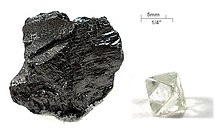
Back Koolstof Afrikaans Kohlenstoff ALS ካርቦን Amharic Carbonio AN कार्बन ANP كربون Arabic كاربون ARY كاربون ARZ কাৰ্বন Assamese Carbonu AST
 Graphite (left) and diamond (right), two allotropes of carbon | |||||||||||||||||||||||||||||||
| Carbon | |||||||||||||||||||||||||||||||
|---|---|---|---|---|---|---|---|---|---|---|---|---|---|---|---|---|---|---|---|---|---|---|---|---|---|---|---|---|---|---|---|
| Allotropes | graphite, diamond and more (see Allotropes of carbon) | ||||||||||||||||||||||||||||||
| Appearance | graphite: black diamond: clear | ||||||||||||||||||||||||||||||
| Standard atomic weight Ar°(C) | |||||||||||||||||||||||||||||||
| [12.0096, 12.0116][1] | |||||||||||||||||||||||||||||||
| Carbon in the periodic table | |||||||||||||||||||||||||||||||
| |||||||||||||||||||||||||||||||
| Group | group 14 (carbon group) | ||||||||||||||||||||||||||||||
| Period | period 2 | ||||||||||||||||||||||||||||||
| Block | p-block | ||||||||||||||||||||||||||||||
| Electron configuration | [He] 2s2 2p2 | ||||||||||||||||||||||||||||||
| Electrons per shell | 2, 4 | ||||||||||||||||||||||||||||||
| Physical properties | |||||||||||||||||||||||||||||||
| Phase at STP | solid | ||||||||||||||||||||||||||||||
| Sublimation point | 3915 K (3642 °C, 6588 °F) | ||||||||||||||||||||||||||||||
| Density (near r.t.) | amorphous: 1.8–2.1 g/cm3[2] graphite: 2.267 g/cm3 diamond: 3.515 g/cm3 | ||||||||||||||||||||||||||||||
| Triple point | 4600 K, 10,800 kPa[3][4] | ||||||||||||||||||||||||||||||
| Heat of fusion | graphite: 117 kJ/mol | ||||||||||||||||||||||||||||||
| Molar heat capacity | graphite: 8.517 J/(mol·K) diamond: 6.155 J/(mol·K) | ||||||||||||||||||||||||||||||
| Atomic properties | |||||||||||||||||||||||||||||||
| Oxidation states | −4, −3, −2, −1, 0, +1,[5] +2, +3,[6] +4[7] (a mildly acidic oxide) | ||||||||||||||||||||||||||||||
| Electronegativity | Pauling scale: 2.55 | ||||||||||||||||||||||||||||||
| Ionization energies |
| ||||||||||||||||||||||||||||||
| Covalent radius | sp3: 77 pm sp2: 73 pm sp: 69 pm | ||||||||||||||||||||||||||||||
| Van der Waals radius | 170 pm | ||||||||||||||||||||||||||||||
| Other properties | |||||||||||||||||||||||||||||||
| Natural occurrence | primordial | ||||||||||||||||||||||||||||||
| Crystal structure | graphite: simple hexagonal (black) | ||||||||||||||||||||||||||||||
| Crystal structure | diamond: face-centered diamond-cubic (clear) | ||||||||||||||||||||||||||||||
| Speed of sound thin rod | diamond: 18,350 m/s (at 20 °C) | ||||||||||||||||||||||||||||||
| Thermal expansion | diamond: 0.8 µm/(m⋅K) (at 25 °C)[8] | ||||||||||||||||||||||||||||||
| Thermal conductivity | graphite: 119–165 W/(m⋅K) diamond: 900–2300 W/(m⋅K) | ||||||||||||||||||||||||||||||
| Electrical resistivity | graphite: 7.837 µΩ⋅m[9] | ||||||||||||||||||||||||||||||
| Magnetic ordering | diamagnetic[10] | ||||||||||||||||||||||||||||||
| Molar magnetic susceptibility | −5.9·10−6 (graph.) cm3/mol[11] | ||||||||||||||||||||||||||||||
| Young's modulus | diamond: 1050 GPa[8] | ||||||||||||||||||||||||||||||
| Shear modulus | diamond: 478 GPa[8] | ||||||||||||||||||||||||||||||
| Bulk modulus | diamond: 442 GPa[8] | ||||||||||||||||||||||||||||||
| Poisson ratio | diamond: 0.1[8] | ||||||||||||||||||||||||||||||
| Mohs hardness | graphite: 1–2 diamond: 10 | ||||||||||||||||||||||||||||||
| CAS Number | 7440-44-0 | ||||||||||||||||||||||||||||||
| History | |||||||||||||||||||||||||||||||
| Discovery | Egyptians and Sumerians[12] (3750 BCE) | ||||||||||||||||||||||||||||||
| Recognized as an element by | Antoine Lavoisier[13] (1789) | ||||||||||||||||||||||||||||||
| Isotopes of carbon | |||||||||||||||||||||||||||||||
| |||||||||||||||||||||||||||||||
Preview warning: unknown parameter "electron configuration"
Preview warning: unknown parameter "category comment"
Preview warning: unknown parameter "period"
Preview warning: unknown parameter "block"
Preview warning: unknown parameter "allotropes"
Preview warning: unknown parameter "oxidation states"
Preview warning: unknown parameter "isotopes"
Preview warning: unknown parameter "group"
Preview warning: unknown parameter "category"
Preview warning: unknown parameter "oxidation states comment"
Carbon is a very important chemical element, with a chemical symbol of C. All known life on Earth needs it to survive. Carbon has atomic mass 12 and atomic number 6. It is a nonmetal, meaning that it is not a metal.
When iron is alloyed with carbon, hard steel is formed. Carbon in the form of coal is an important fuel.
- ↑ "Standard Atomic Weights: Carbon". CIAAW. 2009.
- ↑ Lide, D. R., ed. (2005). CRC Handbook of Chemistry and Physics (86th ed.). Boca Raton (FL): CRC Press. ISBN 0-8493-0486-5.
- ↑ Haaland, D (1976). "Graphite-liquid-vapor triple point pressure and the density of liquid carbon". Carbon. 14 (6): 357–361. doi:10.1016/0008-6223(76)90010-5.
- ↑ Savvatimskiy, A (2005). "Measurements of the melting point of graphite and the properties of liquid carbon (a review for 1963–2003)". Carbon. 43 (6): 1115–1142. doi:10.1016/j.carbon.2004.12.027.
- ↑ "Fourier Transform Spectroscopy of the Electronic Transition of the Jet-Cooled CCI Free Radical" (PDF). Retrieved 2007-12-06.
- ↑ "Fourier Transform Spectroscopy of the System of CP" (PDF). Retrieved 2007-12-06.
- ↑ "Carbon: Binary compounds". Retrieved 2007-12-06.
- ↑ 8.0 8.1 8.2 8.3 8.4 Properties of diamond, Ioffe Institute Database
- ↑ "Material Properties- Misc Materials". www.nde-ed.org. Retrieved 12 November 2016.
- ↑ Magnetic susceptibility of the elements and inorganic compounds, in Handbook of Chemistry and Physics 81st edition, CRC press.
- ↑ Weast, Robert (1984). CRC, Handbook of Chemistry and Physics. Boca Raton, Florida: Chemical Rubber Company Publishing. pp. E110. ISBN 0-8493-0464-4.
- ↑ "History of Carbon and Carbon Materials - Center for Applied Energy Research - University of Kentucky". Caer.uky.edu. Retrieved 2008-09-12.
- ↑ Senese, Fred (2000-09-09). "Who discovered carbon?". Frostburg State University. Retrieved 2007-11-24.
- ↑ "Fourier Transform Spectroscopy of the System of CP" (PDF). Retrieved 2007-12-06.
- ↑ "Fourier Transform Spectroscopy of the Electronic Transition of the Jet-Cooled CCI Free Radical" (PDF). Retrieved 2007-12-06.
- ↑ "Carbon: Binary compounds". Retrieved 2007-12-06.


